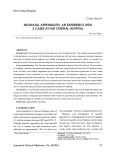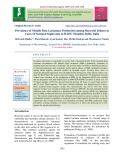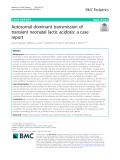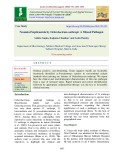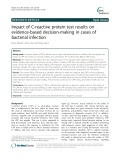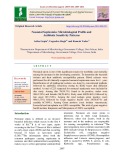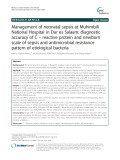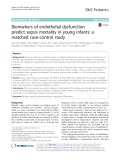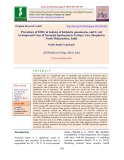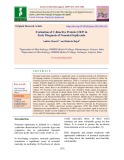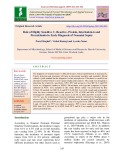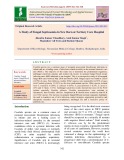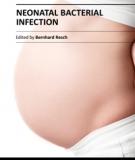
Cases of neonatal sepsis
-
The first case presented at Neonatal Intensive Care Unit with an 18-hour-history of irritability, vomiting, and abdominal distension. With high white blood cell count and C-reactive protein level, the baby was initially diagnosed with neonatal sepsis. The ultrasound performed on day 3 after hospitalization found peritonitis but not seen appendicitis.
 6p
6p  inception36
inception36
 30-11-2021
30-11-2021
 10
10
 1
1
 Download
Download
-
Neonatal septicemia is a clinically diagnosed condition having diverse etiology and changing antibiotic sensitivity pattern. The knowledge of common bacterial agents causing septicemia and their antibiogram is useful in deciding empirical antimicrobial therapy. The neonatal blood cultures were studied to know the bacterial species and their antibiotic sensitivity pattern. Aim of the study is to evaluate sensitivity pattern of bacterial isolates causing neonatal septicemia and to know clinical outcome of the cases.
 9p
9p  angicungduoc6
angicungduoc6
 20-07-2020
20-07-2020
 13
13
 1
1
 Download
Download
-
Neonatal septicemia is responsible for nearly half of neonatal deaths. With emerging drug resistance mechanisms like Metallo Beta lactamase (MBL) production, treatment of neonatal sepsis has become a challenge. The present study was done to identify prevalence of bacterial pathogens, their resistance profile and incidence of MBL mediated resistance among Gram negative bacterial isolates in neonatal sepsis. Seventy three cases of suspected neonatal septicemia were included in this prospective study. Blood culture was done by BacT/Alert 3D system, bacterial isolates were identified.
 7p
7p  angicungduoc6
angicungduoc6
 20-07-2020
20-07-2020
 10
10
 1
1
 Download
Download
-
Lactic acidosis is a common finding in neonates, in whom mitochondrial dysfunction is often secondary to tissue hypoperfusion, respiratory failure, and/or sepsis. Primary (non-physiological) lactic acidosis is comparatively rare, and suggests the presence of an inborn error of mitochondrial energy metabolism.
 4p
4p  viorochimaru2711
viorochimaru2711
 29-05-2020
29-05-2020
 12
12
 0
0
 Download
Download
-
Oxidase positive, non-fermenting, Gram negative bacilli are invariably incorrectly identified as Pseudomonas species in conventional culture methods often missing out isolates of Ochrobactrum anthropi. We report here the clinical and microbiological characteristics of this rare pathogen from a case of neonatal sepsis. Rapid isolation and correct identification followed by appropriate antimicrobial therapy was the key to favourable clinical outcome.
 4p
4p  angicungduoc4
angicungduoc4
 26-04-2020
26-04-2020
 19
19
 2
2
 Download
Download
-
C-reactive protein (CRP) is widely used to detect bacterial infection in children. We investigated the impact of CRP test results on decision-making and summarized the evidence base (EB) of CRP testing.
 7p
7p  virubber2711
virubber2711
 21-03-2020
21-03-2020
 13
13
 0
0
 Download
Download
-
Neonatal sepsis is one of the significant reasons for morbidity and mortality among the neonates in the developing countries. To determine the bacterial isolates and their antibiotic susceptibility pattern. Blood cultures were performed for all clinically suspected neonatal septicemia cases for 1 year. Identification of all pathogenic isolates was done by conventional methods followed by antibiotic sensitivity testing by Kirby bauer disk diffusion method. A total of 225 suspected for neonatal septicemia were included in this study. Among this 78(34.
 6p
6p  nguathienthan3
nguathienthan3
 27-02-2020
27-02-2020
 26
26
 0
0
 Download
Download
-
Single CRP in combination with RNSOS can be used for rapid identification of neonates with sepsis due to high sensitivity (95.6%) but cannot exclude those without sepsis due to low specificity (56.4%). Serial CRP done 12hrs apart can be used to exclude non-cases. This study demonstrated very high levels of resistance to the first-line antibiotics.
 7p
7p  vichengshin2711
vichengshin2711
 26-02-2020
26-02-2020
 17
17
 1
1
 Download
Download
-
The main causative pathogens of NS in our hospital were Gram-positive cocci, among which coagulase-negative Staphylococcus spp such as S. epidermidis and S. haemolyticus were the main conditional pathogens; among Gram-negative pathogens, Klebsiella pneumoniae were most frequently isolated and showed widespread resistance to penicillins and cephalosporins.
 6p
6p  videshiki2711
videshiki2711
 19-02-2020
19-02-2020
 14
14
 0
0
 Download
Download
-
Reducing death due to neonatal sepsis is a global health priority, however there are limited tools to facilitate early recognition and treatment. We hypothesized that measuring circulating biomarkers of endothelial function and integrity (i.e. Angiopoietin-Tie2 axis) would identify young infants with sepsis and predict their clinical outcome.
 12p
12p  vidr2711
vidr2711
 19-02-2020
19-02-2020
 13
13
 1
1
 Download
Download
-
Neonatal sepsis is a significant cause of morbidity and mortality in newborns and is responsible for 30 – 50 % of total neonatal deaths. Multidrug resistant Gram negative bacilli belonging to the family Enterobcteriaceae have been increasingly responsible for infections among the neonates admitted to the NICU in many countries including India. The study was conducted to know prevalence of ESBL production in Klebsiella pneumoniae and Escherichia coli in NICU so that we can help clinicians to avoid injudicious use of antibiotics.
 6p
6p  quenchua2
quenchua2
 18-12-2019
18-12-2019
 12
12
 1
1
 Download
Download
-
Neonatal septicemia constitutes a significant cause of neonatal mortality & morbidity in developing countries. It becomes essential to diagnose it as early as possible to reduce the mortality and treat with appropriate antibiotics. CRP is a sensitive & good inflammatory marker. Definite diagnosis of septicemia depends on positive blood culture, which takes around 48-72 hrs. Result of CRP test is available within an hour in tertiary care centers and remote areas, where there is no availability of well equipped laboratory setup for blood culture.
 7p
7p  kethamoi2
kethamoi2
 15-12-2019
15-12-2019
 13
13
 1
1
 Download
Download
-
The diagnosis of neonatal sepsis is difficult because clinical manifestation is non-specific. Timely detection and treatment will help in decreasing mortality and morbidity. Blood culture is gold standard but the diagnosis is often retrospective. Thus there is a need for an alternative method which is more rapid, reliable and sensitive. This study was designed to determine the sensitivity, specificity, NPV, PPV and accuracy of hs-CRP, IL-6 and PCT levels, as a diagnostic marker of EONS. 206 neonates with sign and symptoms of sepsis admitted in NICU were included in this study.
 8p
8p  kethamoi2
kethamoi2
 14-12-2019
14-12-2019
 45
45
 2
2
 Download
Download
-
Candida species are a common cause of neonatal nosocomial bloodstream infections in infants and are a leading cause of infectious-related mortality in the neonatal intensive care unit (NICU). The objective of this study was to determine the predominant organisms, antifungal sensitivity patterns and clinical risk factors in neonatal fungal blood stream infection cases (BSI) admitted to our hospital. This is a retrospective study of all neonatal fungal BSI cases between May 2018 and October 2018. Fungal sepsis was found in 25/210 (11.9%) of cases.
 7p
7p  nguaconbaynhay1
nguaconbaynhay1
 08-12-2019
08-12-2019
 16
16
 1
1
 Download
Download
-
Neonatal sepsis still remains a significant cause of morbidity and mortality in the newborn, particularly in preterm, low birth weight infants. Despite advances in neonatal care, overall case-fatality rates from sepsis may be as high as 50%. Clinical signs of bacterial infection are vague and non-specific, and up to now there exists no easily available, reliable marker of infection despite a large bulk of studies focussing on inflammatory indices in neonatology. Every neonatologist is faced with the uncertainty of under- or over- diagnosing bacterial infection.
 104p
104p  bunmang_1
bunmang_1
 03-05-2013
03-05-2013
 64
64
 8
8
 Download
Download
CHỦ ĐỀ BẠN MUỐN TÌM








